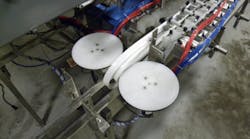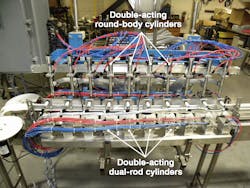Packaging may seem like an afterthought, but not to those in retail sales. While packaging can have a huge influence on the buying decision, it can also be the most complicated aspect of the manufacturing process by requiring specialized machines customized to a particular product design. And that’s exactly where Riada Equipment stands out. Based in Winder, Ga., Riada has been solving problems for cleaning product, food and beverage, textile, cosmetic, lubricant, and glue and adhesive producers since 1984. The company offers new bottling equipment and also remanufactures existing equipment.
When a long-time customer ran encountered a difficult bottling application, they turned to Riada to solve it. The difficulty in this particular application centered on uniquely-shaped shampoo bottles. The oval containers prevented them from being stacked. Instead, each bottle had to be indexed, then clamped individually for the filling sequence. To accomplish this, Riada specified a programmable logic controller and associated system components from AutomationDirect.
This overall view of the machine shows the round-body and dual-rod cylinders piped with color-coded tubing to aid troubleshooting.
Controlling Machine Motion
The machine entry section consists of a set of spacing wheels that move the bottles onto the machine belt conveyor for filling. These wheels are spun by a pair of dc motors at a speed slightly less than the belt conveyor. The feed wheels space the bottles at the correct distance for the fill nozzles and bottle clamps. The belt conveyor speed is regulated by a GS2 series ac drive, also supplied by AutomationDirect.
As the bottles enter the machine, they are counted by an MVP series retro-reflective photo eye. If the machine is set up for a 10-bottle run, then 10 bottles are counted on the way in. The bottle count is decremented as bottles exit the machine, and the machine cycle is halted if the total count doesn’t reach zero.
Double-acting, round-body air cylinders actuate entry and exit gates to control the overall 10-bottle group container flow into and out of the machine to downstream operations. Double-acting E-Series dual-rod guided cylinders, located at each of the 10 fill stations, actuate a clamp to hold bottles during filling. The dual-rod design prevents piston-rod rotation and minimizes any side-to-side movement. This is critical to the clamping sequence to minimize clamp-settling time.
Manifold-mounted AVS-5 series 5-port 4-way solenoid valves direct compressed air to extend or retract the double-acting pneumatic cylinders. MLA series air header manifolds were added at front and rear of the machine to distribute air with minimum piping runs, with the result being higher air pressure and more consistent cycle times.
An MV2-series photo-eye at each station individually detects the presence of a bottle and controls the clamping sequence. The MV2 diffuse-type photo eye conserves valuable space at each station to sense the presence of a bottle because a reflector or receiver is not needed on the other side of the sensing line.
An AFR series filter-regulator provides the machine with clean air at the right pressure, and Riada added a third-party receiver to provide excess capacity and minimize any drops in air pressure regardless of the real-time air load, ensuring consistent cycle times. Different-color tubing for extension, retraction, pressure, and exhaust lines used to aid troubleshooting.
NFPA tie-rod cylinders actuate metering cylinders, which dispense the correct amount of product into each bottle.
Dispensing Operations
Filling Riada’s customer’s containers with product is the primary job of the machine. All equipment with surfaces touching the product meets FDA specification, including the stainless steel metering cylinders and shut-off stopper cylinders at each nozzle. These product metering cylinders are actuated by D-series NFPA tie-rod cylinders.
A mechanical stop is threaded onto a threaded section of each double-acting cylinder’s rod. Manually adjusting the effective rod length varies the stroke of the tie-rod cylinder, which, in turn, varies the volume dispensed by the metering cylinder—a simple- yet-effective design.
Control and Operator Interface
The entire machine sequence is controlled by a DirectLogic DL-06 programmable logic controller. This brick-style unit contains both the CPU and sufficient I/O to meet the machine requirements. A six-inch EA9 series color touchscreen C-more display allows for flexible machine product and cycle time setup. The display is used to set up various timers and variables for the filling process. It’s also used to control machine start and stop, minimizing the need for pushbuttons.
Besides operating screens, a maintenance screen is included. This screen allows operators to run the machine dry for testing various components and operations. Typical dry runs include clamping and unclamping of bottles, raising and lowering fill heads, and running the machine through its entire sequence without dispensing any product.
Test and Results
Shop testing performed at the Riada facility revealed minor PLC program changes were needed and were conducted remotely by Riada’s systems integrator, Systems & Controls, of Lenoir City, Tenn. A PF at the integrator was connected remotely to Riada’s shop floor PC running DirectLogic programming software. The connection was made over a wireless plant network at Riada.
Successful shop test and product run-off with the customer allowed Riada to receive final signoff prior to shipment. The machine has been running for two shifts a day since Nov. 2014 without interruption. Due to these successful results, the customer ordered and Riada delivered clamping systems for two of the customer’s existing machines.
Winn Paulk is community platform development manager at AutomationDirect, Cumming, Ga., For more information, call (800) 633-0405 or visit www.automationdirect.com.




